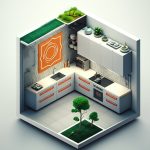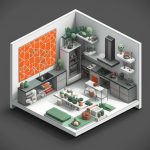Ever wondered what makes a traditional home so appealing? It’s more than just pretty pictures; it’s about a timeless elegance that feels both comforting and stylish. This article dives into the world of traditional home design, showing you how to blend classic charm with today’s modern needs. We’ll cover everything from understanding the basics of traditional styles to making sure your home is both beautiful and practical – and even how to make it eco-friendly! Whether you’re building a new home or just dreaming about one, this guide is packed with helpful advice and inspiration to help you create your perfect traditional space. For more ideas on spatial planning, check out these traditional floor plans.
Traditional House Design Concepts: Where Classic Charm Meets Modern Living
Ever noticed how some houses just seem to exude a timeless quality? That’s often the magic of traditional house design. It’s not just about looks; it’s about a feeling – a sense of history, quality craftsmanship, and enduring elegance that draws you in. Think of beautifully balanced facades, inviting spaces, and those charming details that whisper stories of the past. But don’t picture stuffy, outdated homes. Today’s take on traditional design cleverly blends those classic elements with modern comforts and eco-friendly touches, creating homes that are both stunning and practical.
Traditional home design emphasizes symmetry, balance, and detailed craftsmanship, drawing inspiration from historical architectural styles like Colonial, Victorian, and Georgian. These homes often feature pitched roofs, evenly spaced windows, and a focus on creating a warm, inviting atmosphere. The enduring appeal of traditional design lies in its ability to evoke feelings of stability, heritage, and refined beauty.
Decoding the Elements of Traditional Style: Architectural Harmony
What makes a house truly “traditional”? Several key features come to mind. Balance is everything – you’ll often see symmetrical designs, creating a pleasing harmony to the eye. Classic architectural details add a touch of sophistication – think graceful columns, ornate moldings, and decorative cornices. These homes typically boast high ceilings, letting in plenty of natural light through large windows, and generously sized rooms designed for comfortable living. And it’s all about quality materials; natural wood, stone, and brick are common choices, lending a sense of permanence and richness. Imagine it like a perfectly tailored suit – the cut is flattering, but the superior fabric and superb detailing elevate it to another level.
Consider the key architectural elements that define traditional style:
- Symmetrical Facades: A balanced exterior design, often with a central entrance and evenly spaced windows.
- Pitched Roofs: Classic rooflines that add visual interest and architectural depth.
- Detailed Millwork: Ornate moldings, cornices, and trim work that showcase craftsmanship and attention to detail.
- Formal Living Spaces: Well-defined rooms designed for specific purposes, such as a formal dining room or parlor.
- Natural Materials: The use of wood, stone, and brick to create a sense of warmth, durability, and timeless appeal.
Bridging the Gap: Modern Updates to Classic Designs for Today’s Homeowner
While some folks prefer a strictly historical approach, modern versions of traditional homes offer exciting possibilities. Open-plan layouts, usually associated with modern architecture, now beautifully coexist with traditional styles. Picture a spacious kitchen flowing effortlessly into a sun-drenched family room, all nestled within the elegant framework of a Colonial or Georgian-style home. It’s a harmonious blend of past and present, the best of both worlds.
Energy efficiency is another crucial area where modern designs shine. Integrating smart home technology and eco-friendly materials doesn’t detract from the classic look; in fact, it often enhances it. This is about making traditional homes functional and comfortable for modern lifestyles without compromising their inherent charm. It’s about smart choices that elevate both the home’s beauty and practicality.
Modern updates to traditional designs include:
- Open Floor Plans: Creating a more connected and versatile living space while retaining the architectural integrity of the home.
- Energy-Efficient Windows: Utilizing modern window technologies to improve insulation and reduce energy consumption.
- Updated Kitchens and Bathrooms: Incorporating contemporary appliances, fixtures, and materials while maintaining a classic aesthetic.
- Smart Home Integration: Seamlessly integrating technology for lighting, security, and climate control without sacrificing the home’s traditional charm.
Choosing the Right Materials and Colors: Setting the Stage for Timeless Style with Interior Design
The materials you choose significantly impact the overall feel and longevity of a traditional home. High-quality, durable materials like solid hardwood floors, granite countertops, and solid wood cabinetry are investments that pay off over time. Think of them as the foundation for your home’s enduring elegance. They offer not only beauty but also lasting value.
Neutral color palettes often form the base, with pops of richer jewel tones added sparingly. Instead of bold statements, these color schemes exude understated elegance. This approach allows for flexibility; you can personalize your space with artwork and accessories without disrupting the overall harmony. It’s about creating a calming and sophisticated backdrop that allows your personal style to shine.
When selecting materials and colors for a traditional home, consider:
- Hardwood Flooring: Opt for classic wood species like oak, maple, or walnut in rich, warm tones.
- Natural Stone: Incorporate granite, marble, or limestone for countertops, fireplace surrounds, and flooring.
- Solid Wood Cabinetry: Choose cabinetry with raised-panel doors, detailed moldings, and a timeless finish.
- Neutral Color Palettes: Use soft whites, creams, beiges, and grays as a foundation, adding pops of color with accessories and textiles.
- Rich Jewel Tones: Accent the neutral palette with deep blues, greens, reds, and golds to create a sense of warmth and luxury.
Adapting Tradition for Today’s World: Sustainability and Smart Technology Integration
A true test of any design style is its ability to adapt and evolve. Traditional home design, for all its classic appeal, needs to meet the demands of modern life. This means addressing two significant areas: sustainability and smart technology integration. Incorporating solar panels (devices that convert sunlight into electricity) subtly, selecting sustainably sourced lumber, and choosing energy-efficient appliances aren’t just environmentally responsible; they’re smart design choices that increase a home’s value and appeal. Similarly, integrating smart technology – from lighting controls to advanced security systems – can be done tastefully, preserving the home’s character while enhancing functionality. These enhancements allow for convenience and efficiency without sacrificing the charm of the traditional design.
To adapt traditional designs for modern living, consider:
- Energy-Efficient Appliances: Opt for Energy Star-rated appliances to reduce energy consumption and lower utility bills.
- Sustainable Building Materials: Use eco-friendly materials like bamboo flooring, reclaimed wood, and recycled-content insulation.
- Smart Home Technology: Integrate smart lighting, thermostats, and security systems to enhance convenience and energy efficiency.
- Solar Panels: Install solar panels discreetly to generate clean energy and reduce your carbon footprint.
Different Perspectives on Traditional Design: A Look at the Stakeholders and Their Objectives
Here’s a glimpse into the goals and perspectives of different groups involved in creating and inhabiting traditional homes:
| Stakeholder Group | Short-Term Goals (0-1 Year) | Longer-Term Goals (3-5 Years) |
|---|---|---|
| Homeowners/Developers | Researching styles, choosing high-quality materials, exploring energy-efficient options | Investing in durable materials, integrating smart home tech, adapting to changing design trends |
| Architects/Designers | Staying updated on design trends, collaborating with other professionals, specializing in sustainable techniques | Developing expertise in blending traditional and contemporary elements, collaborating with craftspeople |
| Material Suppliers | Providing eco-friendly and ethically sourced materials, expanding product lines | Innovating new materials, focusing on durability and sustainability, partnering with design professionals |
Understanding the objectives of different stakeholders can help streamline the design and construction process, ensuring that the final result meets everyone’s needs and expectations.
The Future of Traditional Design: A Living Legacy and Its Evolution
Traditional home design isn’t stuck in the past; it’s a living, breathing style. Its constant evolution shows a commitment to preserving timeless elegance while adapting to present-day needs. We can expect increasingly innovative and sustainable interpretations of these enduring principles. The question isn’t whether tradition will endure, but how creatively we’ll shape its future. The outcome? Homes that effortlessly blend historical resonance with modern beauty and practicality. The result will be homes that feel both familiar and excitingly new.
The future of traditional design will likely focus on:
- Sustainability: Incorporating eco-friendly materials and energy-efficient technologies to minimize environmental impact.
- Smart Home Integration: Seamlessly integrating technology for enhanced convenience, security, and energy management.
- Adaptability: Designing homes that can adapt to changing lifestyles and needs over time.
- Personalization: Allowing homeowners to customize their spaces with unique design elements that reflect their individual tastes and preferences.
How to Incorporate Smart Home Technology in Traditional House Designs
Key Takeaways:
- Successfully integrating smart technology into a traditional home hinges on a careful balance between modern convenience and preserving its historical charm.
- Thorough planning is key; assess your Wi-Fi, existing electrical systems, and desired level of automation before starting any installations.
- Choose smart home devices that complement, not clash with, the existing aesthetic. Think subtle integration, not
- Modern Backsplash Ideas: A Guide to Todays Kitchen Trends - December 18, 2025
- Ceramic Kitchen Wall Tiles: Style and Protection for Your Walls - December 17, 2025
- Kitchen tiling wall: Elevate your kitchen with stylish wall tiles - December 16, 2025









